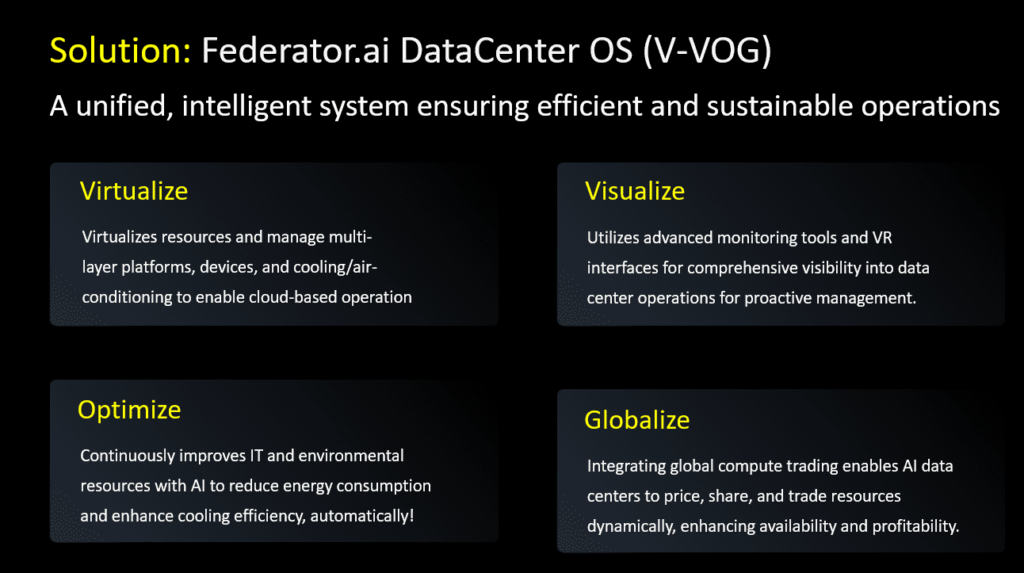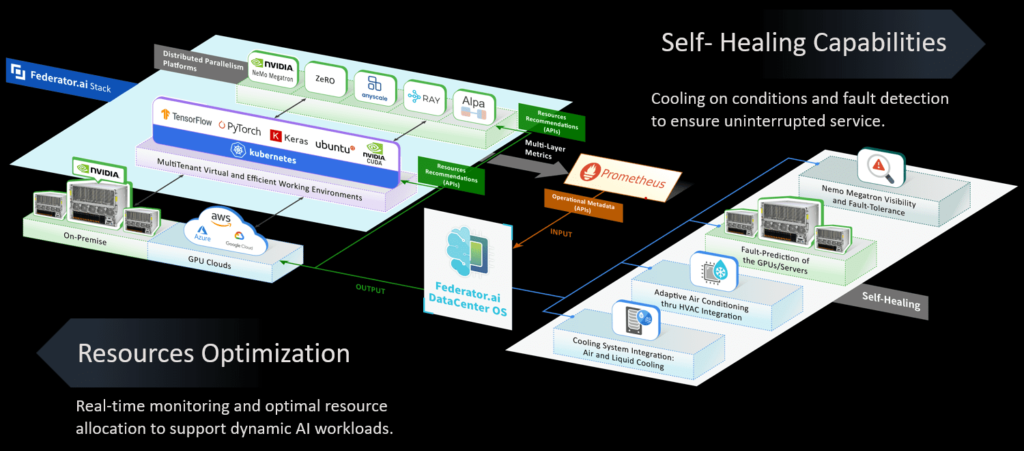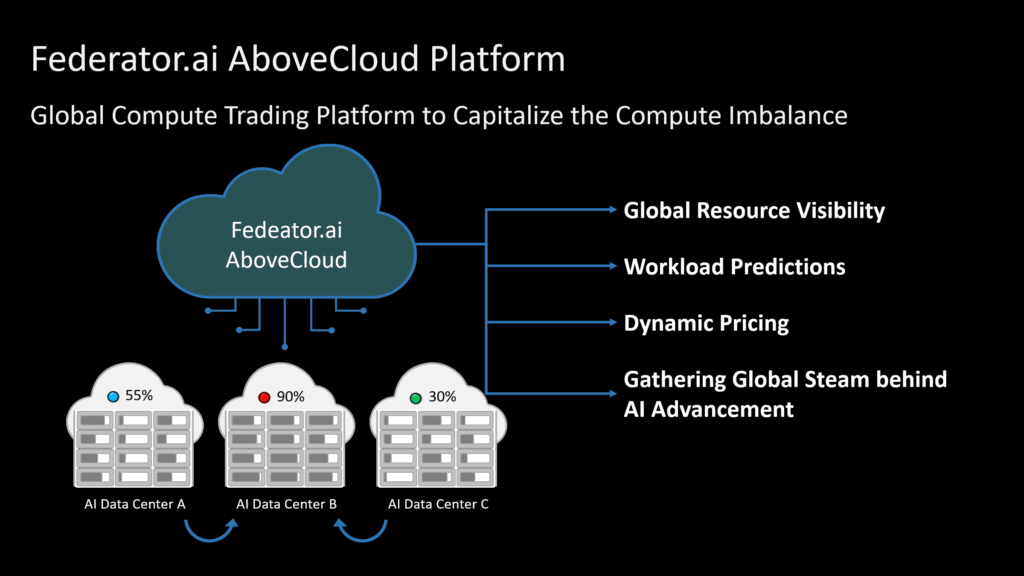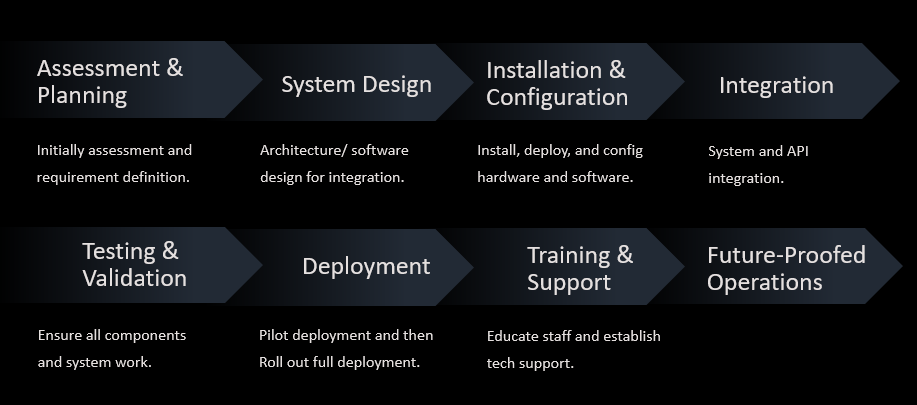I. Executive Summary
AI technologies have significantly transformed various sectors, leading to unprecedented demands on data centers. Traditional data centers, however, are grappling with the increasing complexity and substantial energy requirements of AI workloads. This necessitates a shift in the conventional wisdom of data center management, especially considering factors such as electricity, cooling, and overall operational efficiency.
Current Challenges and Issues
Increasing Demand for AI Data Centers: As highlighted in the comprehensive analysis “Situational Awareness: The Decade Ahead” by Leopold Aschenbrenner, the rapid progression towards Artificial General Intelligence (AGI) and subsequent superintelligence necessitates a substantial upgrade in data center infrastructure. The shift from $10 billion to potentially trillion-dollar clusters within a decade underscores the exponential growth in computational demands. This transition involves significant investments in GPU clusters, data centers, and the associated power infrastructure, which is predicted to see trillions of dollars in investments by the end of the decade.
Energy and Cooling Requirements: Traditional data centers consume vast amounts of electricity and face challenges in cooling efficiency, particularly as AI workloads intensify. The ‘Electricity 2024’ report underscores the need for innovative solutions to manage the dramatic increases in power consumption projected for the near future. This analysis suggests that merely relying on existing energy solutions will be insufficient to meet the escalating demands, highlighting the importance of creativity and out-of-the-box thinking in energy sourcing and cooling methodologies.
Efficiency and Sustainability: Managing data centers efficiently while adhering to sustainability goals is becoming increasingly complex. However, the proposed paradigm shift towards more intelligent, AI-driven solutions offers a promising future. These solutions can proactively manage resources, optimize energy use, and ensure sustainability, providing a ray of hope in the face of AI’s dynamic workload patterns.
Solutions for AI-Defined Data Centers
AI-Defined Data Centers (ADDCs): An AI-Defined Data Center (ADDC) leverages advanced AI technologies to manage and optimize data center operations. Unlike traditional Software-Defined Data Centers (SDDCs), which rely on software for managing resources, ADDCs employ AI for a more dynamic and efficient management approach. This includes:
- Virtualization: AI enhances traditional virtualization by dynamically allocating resources such as CPUs, GPUs, and memory based on real-time workload demands, ensuring optimal utilization and reducing wastage.
- Visualization: Advanced monitoring tools and virtual reality interfaces provide comprehensive visibility into data center operations, enabling real-time insights and proactive management.
- Automation: AI-driven automation can predict workload patterns and adjust resources accordingly, minimizing downtime and ensuring smooth operations.
- Optimization: Continuous optimization of IT and environmental resources through AI reduces energy consumption and enhances cooling efficiency, supporting sustainability goals.
Proactive Management: Federator.ai DataCenter OS embodies these principles, offering a unified, intelligent operating system that ensures efficient and sustainable operations. By integrating advanced AI capabilities, Federator.ai can proactively manage resources, optimize environmental controls, and address potential issues before they occur. This proactive approach enhances reliability and performance while reducing operational costs.
Global Compute Trading: We Define’s Federator.ai AboveCloud platform integration facilitates global compute trading, allowing data centers to share and trade computational resources efficiently. This innovative feature enhances resource availability and provides a significant competitive advantage in managing peak workloads and scaling operations globally.
Conclusion
Federator.ai DataCenter OS is poised to revolutionize AI-Defined Data Center management. By addressing the critical issues of increasing AI demands, energy consumption, cooling efficiency, and sustainability, Federator.ai offers a comprehensive solution that ensures high efficiency, scalability, and environmental responsibility. Stakeholders and potential customers are encouraged to embrace this transformative journey towards the next generation of AI data centers, leveraging the advanced capabilities of Federator.ai to stay ahead in the rapidly evolving landscape of AI technology.
II. Introduction
AI technologies are evolving remarkably, creating unprecedented demands on data centers. Traditional data centers are increasingly struggling to cope with modern AI workloads’ complexity and energy requirements. As highlighted in the “Electricity 2024” report, the exponential growth in AI applications and the corresponding surge in electricity consumption drive the need for a new approach to data center management. Conventional wisdom in managing data centers must adapt to these new realities, where electricity, cooling, and efficiency requirements are fundamentally different. Federator.ai DataCenter OS is designed to meet these challenges head-on, offering a unified, intelligent operating system that optimizes IT and environmental resources, ensuring efficient and sustainable operations.
Defining AI-Defined Data Center (ADDC)
An AI-Defined Data Center (ADDC) represents the next generation of data center architecture. Unlike traditional Software-Defined Data Centers (SDDCs), which rely primarily on software for managing and optimizing resources, ADDCs leverage advanced AI technologies to automate and optimize all aspects of data center operations. This includes IT resource management and environmental controls, such as cooling and power usage. The AI-driven approach allows ADDCs to anticipate and respond to workload demands proactively, ensuring high efficiency and sustainability.
Comparison to Conventional Software-Defined Data Centers (SDDCs)
Software-Defined Data Centers (SDDCs):
- Virtualization: SDDCs utilize virtualization to abstract physical resources into virtual entities, enabling flexible and efficient resource management.
- Visualization: SDDCs provide basic monitoring and management tools, often limited in scope and real-time capabilities.
- Automation: SDDCs incorporate automation to streamline operations based on predefined rules and configurations.
- Optimization: SDDCs rely on static optimization rules, which can be inefficient in adapting to dynamic workload demands.
AI-Defined Data Centers (ADDCs):
- Virtualization: Like SDDCs, ADDCs leverage virtualization but enhance it by using AI to manage virtual resources dynamically and efficiently.
- Visualization: ADDCs offer enhanced visibility through advanced monitoring tools and virtual reality interfaces, allowing real-time insights into data center operations and maintenance.
- Optimization: ADDCs continuously optimize both IT and environmental resources using AI, ensuring that energy consumption and cooling are adjusted based on real-time demands. This coordinated optimization supports workloads effectively and efficiently.
- Globalization: ADDCs integrate global compute trading capabilities, enabling data centers to share and trade computational resources globally, enhancing resource availability and operational flexibility.

Proactive Management
Federator.ai DataCenter OS embodies the principles of Virtualize, Visualize, Optimize, and Globalize (V-VOG), making it a comprehensive solution for modern data center management. Here’s how it excels in each area:
Virtualize:
Federator.ai uses AI to enhance traditional virtualization techniques, dynamically allocating resources such as CPUs, GPUs, and memory based on real-time workload demands. This ensures that resources are utilized efficiently, reducing waste and improving overall performance.
Visualize:
The system provides enhanced visibility into data center operations through advanced monitoring tools and virtual reality interfaces. These tools allow data center managers to visualize real-time data on resource usage, environmental conditions, and workload performance. This comprehensive visibility aids in proactive management and quick resolution of potential issues.
Optimize:
Federator.ai continuously optimizes data center operations, from IT resource management to environmental controls. By leveraging AI-driven automation, the system can predict workload patterns and adjust resource allocation and environmental controls accordingly. This coordinated optimization ensures that both IT and environmental resources are managed effectively to support workloads, improving efficiency and sustainability. This proactive approach minimizes the risk of downtime and ensures optimal performance, all while reducing the need for manual intervention.
Globalize:
Federator.ai integrates with We Define’s Federator.ai AboveCloud platform, facilitating global compute trading. This enables data centers to share and trade computational resources efficiently, ensuring that resources are available where and when they are needed most. This global computing trading capability enhances resource availability, scalability, and operational flexibility, providing a significant competitive advantage.
Federator.ai DataCenter OS ensures that all these features work seamlessly to provide a proactive management solution. The system can identify and resolve potential issues before they occur, leading to a more stable and reliable data center environment. This proactive management approach is crucial for maintaining high performance and efficiency in the face of rapidly evolving AI workloads.
In conclusion, Federator.ai DataCenter OS represents a significant advancement in data center management. Integrating advanced AI capabilities with comprehensive resource and environmental management provides a sustainable, efficient, and scalable solution for the future. Stakeholders and potential customers are encouraged to join this transformative journey towards the next generation of AI data centers, benefiting from improved performance, reduced costs, and enhanced sustainability.
III. The Need for Federator.ai DataCenter OS
Growing Demands of AI Workloads
The exponential growth in AI applications has led to an unprecedented demand for computational power and sophisticated resource management. Traditional data centers are often ill-equipped to handle these demands, as they were not designed with AI workloads in mind. This creates a pressing need for an advanced data center operating system to efficiently manage resources and optimize operations to support AI’s evolving requirements.
Challenges with Current Data Center Operations
Energy Consumption:
Traditional data centers are significant energy consumers. The high computational demands of AI workloads, combined with the need for intensive cooling, drive up energy usage. This not only increases operational costs but also has a substantial environmental impact.
Resource Allocation:
Allocating resources such as CPUs, GPUs, memory, and storage efficiently to meet dynamic AI workload demands is increasingly complex. Traditional resource management approaches often lead to underutilization or overprovisioning, both of which are inefficient.
Cooling and Environmental Management:
Maintaining optimal temperatures and environmental conditions is crucial for the performance and longevity of data center equipment. Traditional cooling methods are often inefficient and do not adapt well to the fluctuating demands of AI workloads, leading to higher energy consumption and potential thermal issues.
Networking and Storage:
AI workloads require fast, reliable, and scalable networking and storage solutions. Traditional data centers often struggle to provide the bandwidth and low latency required for efficient AI operations.
Security Measures:
Implementing robust security measures to protect sensitive data and infrastructure is a critical challenge. As AI workloads often involve large datasets and intensive computation, ensuring the security of these operations is paramount.
The Role of AI in Addressing These Challenges
Predictive and Prescriptive Analytics:
AI can analyze vast data to predict and prescribe optimal resource management strategies. By leveraging AI, data centers can anticipate future demands and adjust resources proactively rather than reactively.
Automating Resource Management:
AI-driven automation can dynamically allocate resources based on real-time workload demands. This ensures that resources are used efficiently, reducing waste and improving performance.
Optimizing Cooling and Energy Usage:
AI can optimize cooling strategies by adjusting environmental controls based on current and predicted workload demands. This leads to significant energy savings and improved cooling efficiency.
Enhancing Networking and Storage Solutions:
AI can optimize data flow and storage management, ensuring that AI workloads have the capacity and low latency. This enhances the overall performance of AI applications.
Strengthening Security Measures:
AI can provide advanced security analytics, detecting and responding to potential threats in real time. This ensures that data and infrastructure are protected against evolving security challenges.
By leveraging AI, data centers can:
Virtualize: AI-driven virtualization enables efficient resource utilization by abstracting physical resources and managing them as virtual entities. This allows for greater flexibility and scalability in resource management.
Visualize: AI provides comprehensive visibility into data center operations, enabling administrators to monitor and analyze real-time performance metrics. This helps identify and address inefficiencies promptly.
Optimize: AI-driven optimization ensures that resources are allocated and utilized efficiently, minimizing waste and maximizing performance. This includes optimizing energy usage, cooling, networking, and storage solutions.
Globalize: AI enables global compute trading, allowing data centers to share and trade computational resources across different locations. This enhances resource availability and supports the seamless scaling of AI workloads globally.
The Federator.ai DataCenter OS is designed to address these challenges, providing a unified and intelligent operating system that optimizes IT and environmental resources. Integrating advanced AI capabilities ensures efficient, sustainable, and secure operations, paving the way for the next phase of AI development and supporting the journey toward artificial general intelligence (AGI) and artificial superintelligence (ASI).
IV. Key Features of Federator.ai DataCenter OS

Application-Aware Operations
Federator.ai DataCenter OS is designed to be highly attuned to the specific needs of AI applications. Unlike traditional systems that apply a one-size-fits-all approach to resource management, Federator.ai leverages advanced AI algorithms to understand the unique requirements of each application. This application-aware approach ensures that resources such as CPUs, GPUs, and memory are allocated and utilized most efficiently. By adapting to the demands of individual applications, Federator.ai maximizes performance and minimizes wastage, leading to significant improvements in operational efficiency.
Workload-Sensitive Resource Allocation
In traditional data centers, static resource allocation often leads to inefficiencies through underutilization or overprovisioning. Federator.ai DataCenter OS addresses this by implementing workload-sensitive resource allocation. The system dynamically adjusts resource allocation using real-time data and predictive analytics based on current and anticipated workload demands. This dynamic approach ensures that resources are provided precisely when and where needed, enhancing performance and reducing costs. The ability to respond to real-time workload changes is particularly crucial for AI applications with highly variable and intensive computational needs.
Environmental Management
Effective environmental management is critical to the performance and sustainability of modern data centers. Federator.ai integrates IT and environmental controls, using AI to optimize energy and water use for cooling and air conditioning. The system continuously monitors environmental conditions and adjusts cooling strategies to maintain optimal temperatures while minimizing energy consumption. This reduces operational costs and contributes to the data center’s sustainability goals by lowering its carbon footprint. Advanced AI algorithms predict cooling requirements based on workload patterns, ensuring that cooling resources are used efficiently.
Global Compute Trading with Federator.ai AboveCloud
One of Federator.ai DataCenter OS’s most innovative features is integrating with the Federator.ai AboveCloud platform for global compute trading. This feature allows data centers to trade computational resources globally, enhancing resource availability and utilization. By participating in a global marketplace, data centers can access additional resources during peak demand periods or monetize excess capacity during off-peak times. This global compute trading capability accelerates AI development by ensuring that computational power is available where and when needed most, fostering a more flexible and scalable AI infrastructure.
Comprehensive Integration Capabilities
Federator.ai DataCenter OS is designed with interoperability in mind. It is compatible with various existing data center infrastructures and supports various hardware solutions, including CPUs, GPUs, and specialized AI accelerators. This flexibility ensures that Federator.ai can be deployed in diverse environments, leveraging existing hardware investments and integrating seamlessly with current systems. The system’s architecture supports integrating popular data center management tools, cloud platforms, and APIs, facilitating a smooth transition to an AI-optimized data center.
The comprehensive integration capabilities extend to environmental controls and cooling systems. Federator.ai can interface with advanced cooling technologies, including direct liquid cooling (DLC), to enhance energy efficiency and cooling performance. The ability to integrate with various hardware and software platforms ensures that Federator.ai can provide a unified, intelligent operating system across different types of data center environments.
By addressing these key areas, Federator.ai DataCenter OS offers a holistic solution to the challenges faced by modern AI-driven data centers. It ensures optimal resource utilization, enhances performance, reduces energy consumption, and supports global scalability, making it an essential tool for the next generation of data center operations.
V. Technical Architecture
The technical architecture of Federator.ai DataCenter OS is designed to harness cutting-edge AI technologies to optimize data center operations, ensuring high efficiency, scalability, and sustainability. This robust architecture integrates advanced AI for predictive and prescriptive analytics, dynamic resource management, and comprehensive security, providing a robust and intelligent solution for managing modern AI-driven data centers. It seamlessly incorporates We Define’s Federator.ai AboveCloud platform for global compute trading, ensuring security and compliance at every step.
Advanced AI for Predictive and Prescriptive Analytics
At the core of Federator.ai DataCenter OS are sophisticated AI technologies that enable predictive and prescriptive analytics. These technologies continuously analyze historical and real-time data from various sensors and operational metrics within the data center. By learning from this data, the system can predict potential issues before they occur and recommend or automatically execute corrective actions. For example, predictive analytics can forecast cooling needs based on workload trends, preventing overheating and reducing energy consumption. Prescriptive analytics go a step further by suggesting optimal configurations for resource allocation, including networking, storage, and security measures. This proactive approach minimizes downtime, enhances performance, and ensures the efficient use of resources.
Dynamic Resource Management
Federator.ai DataCenter OS employs dynamic resource management to optimize the utilization of computational resources. This involves the real-time allocation and reallocation of resources such as CPUs, GPUs, and memory based on current and predicted workload demands. The system leverages AI algorithms to monitor workload patterns and adjust resources dynamically to match the needs of applications. This ensures that resources are neither underutilized nor overprovisioned, significantly improving efficiency and cost savings. Dynamic resource management is crucial for AI workloads with highly variable and intensive computational requirements. Federator.ai ensures that applications run smoothly and efficiently by responding to these real-time fluctuations.
Integration with We Define’s Federator.ai AboveCloud
Federator.ai DataCenter OS is seamlessly integrated with We Define’s Federator.ai AboveCloud platform, facilitating global compute trading to optimize resource usage further. Federator.ai AboveCloud allows data centers to trade computational power globally, ensuring that resources are available where and when needed. This global marketplace for compute resources enhances flexibility and scalability, allowing data centers to handle peak demand periods without overprovisioning. By leveraging Federator.ai AboveCloud, Federator.ai can allocate excess resources to other data centers during off-peak times, creating additional revenue streams and improving overall resource utilization.

Security and Compliance
Ensuring security and compliance is a critical aspect of the technical architecture of Federator.ai DataCenter OS. The system incorporates advanced security measures to protect data and infrastructure from potential threats. This includes data encryption at rest and in transit, robust access controls, and continuous monitoring for suspicious activity. AI-driven security analytics can detect and respond to anomalies in real time, providing additional protection against cyber threats. Compliance with industry standards and regulations is also a key focus, ensuring data center operations meet legal and ethical requirements. The architecture is designed to support audit trails and reporting, making it easier for organizations to demonstrate compliance with regulatory mandates.
Comprehensive Integration Capabilities
The architecture of Federator.ai DataCenter OS is built to be highly compatible with a wide range of data center infrastructures. This ensures it can be deployed in diverse environments, leveraging existing hardware investments and integrating with various management systems. The system supports integration with Data Center Infrastructure Management (DCIM) systems, allowing for seamless coordination of IT and facility resources. Additionally, Federator.ai can interface with advanced cooling systems via APIs like the CoolIT API, optimizing energy and water use for cooling and air-conditioning. Integration with cloud management platforms is also supported, enabling hybrid and multi-cloud environments to be managed efficiently from a single interface.
Modular and Scalable Design
The modular and scalable design of Federator.ai DataCenter OS allows it to grow with the needs of the data center. As demand increases, the system can easily expand to support additional nodes, storage, and networking components. This flexibility ensures the data center can scale efficiently to accommodate new AI applications and workloads. The architecture is also designed to support various hardware solutions, including the latest CPUs, GPUs, and specialized AI accelerators. This ensures that Federator.ai can take advantage of the most advanced technologies available, providing a future-proof solution for data center management.
Conclusion
The technical architecture of Federator.ai DataCenter OS represents a state-of-the-art approach to data center management. Integrating advanced AI technologies for predictive and prescriptive analytics, dynamic resource management, and comprehensive security provides a robust and intelligent solution for modern AI-driven data centers. The seamless integration with We Define’s Federator.ai AboveCloud platform for global compute trading further enhances resource optimization and scalability. With its comprehensive integration capabilities and modular design, Federator.ai DataCenter OS ensures that data centers can operate efficiently, sustainably, and securely, meeting the demands of today’s AI applications and preparing for future advancements.
VI. Implementation and Deployment
Implementing Federator.ai DataCenter OS involves a structured approach to ensure a smooth transition and optimal performance. This section outlines a detailed step-by-step implementation guide, focusing on assessment and planning, system design, installation and configuration, integration, testing and validation, deployment, and training and support.
Step-by-Step Implementation Guide

- Assessment and Planning
Initial Assessment:
The first step is to assess the existing data center infrastructure comprehensively. This involves evaluating hardware capabilities, current workloads, energy consumption patterns, cooling efficiency, and overall performance metrics. Understanding these elements provides a baseline against which improvements can be measured and helps identify potential challenges that might arise during implementation.
Requirements Definition:
Clearly define the specific requirements for implementing Federator.ai DataCenter OS. These requirements should include desired outcomes related to performance improvement, energy efficiency, workload management, and sustainability goals. This step ensures that all stakeholders clearly understand what the implementation aims to achieve.
Resource Allocation:
Allocate the necessary resources for the implementation process. This includes procuring the required hardware (such as CPUs, GPUs, and AI accelerators) and software licenses and assembling a team with expertise in AI, data center management, and system integration. Proper resource allocation ensures the project stays on schedule and meets its objectives.
- System Design
Architectural Design:
Develop a detailed architectural design that outlines how Federator.ai DataCenter OS will integrate with the existing systems. This includes network configurations, hardware placements, and software integrations. A well-thought-out architectural design ensures that all components will work together seamlessly and that the system will be scalable and adaptable to future needs.
Component Selection:
Select the appropriate components to be integrated into the data center infrastructure. This includes choosing CPUs, GPUs, AI accelerators, environmental sensors, and cooling systems compatible with Federator.ai DataCenter OS. Selecting the right components is essential for optimizing performance and ensuring the system’s reliability and efficiency.
- Installation and Configuration
Hardware Installation:
Install the required hardware components, ensuring they are correctly placed, connected, and redundant to prevent single points of failure. Proper hardware installation is critical for the system’s stability and performance.
Software Installation:
Deploy Federator.ai DataCenter OS on the designated servers. This involves installing the operating system, AI technologies, and necessary drivers. Ensuring that the software is correctly installed is essential for leveraging the full capabilities of Federator.ai DataCenter OS.
Configuration:
Configure the system settings, including network parameters, resource management policies, security protocols, and environmental controls. Proper configuration ensures that the system operates efficiently and securely.
- Integration
System Integration:
Integrate Federator.ai DataCenter OS with existing data center management tools, such as Data Center Infrastructure Management (DCIM) systems, cloud platforms, and other relevant software. This integration allows for seamless resource and operations management.
API Integration:
Ensure that APIs are properly configured to facilitate seamless communication between Federator.ai DataCenter OS and other systems. This enables efficient data exchange and command execution, enhancing the system’s overall functionality.
- Testing and Validation
Functional Testing:
Conduct thorough functional testing to ensure that all components are working as expected. This includes verifying resource allocation, workload management, and environmental controls. Functional testing helps identify and resolve any issues before the system goes live.
Performance Testing:
Test the system under various load conditions to validate performance metrics. This ensures the system can handle peak workloads efficiently and meets the performance requirements defined during the planning phase.
Security Testing:
Perform security assessments to identify and mitigate potential vulnerabilities. Ensuring robust protection against cyber threats is critical for the safety and integrity of data center operations.
- Deployment
Pilot Deployment:
Begin with a pilot deployment in a controlled environment. This allows for identifying and resolving any issues in a smaller, manageable setting before rolling out the system on a larger scale.
Full Deployment:
Roll out Federator.ai DataCenter OS across the entire data center. Ensure that this process is carried out with minimal disruption to ongoing operations. Full deployment signifies the system is fully operational and ready to support all data center activities.
- Training and Support
Training:
Provide comprehensive training to data center personnel on using and managing Federator.ai DataCenter OS. This should include hands-on sessions, detailed documentation, and ongoing support to ensure staff are fully equipped to use the system effectively.
Support:
Establish a support structure to address any technical issues during and after deployment. Continuous support ensures that any problems can be swiftly addressed, maintaining the smooth operation of the data center.
By following this step-by-step implementation guide, organizations can ensure a successful deployment of Federator.ai DataCenter OS, which will improve performance, efficiency, and sustainability in their data center operations.
VIII. Market Position and Competitive Advantage
Federator.ai DataCenter OS distinguishes itself in the market through its unique combination of AI-driven resource management and advanced environmental controls. This powerful blend positions Federator.ai as a comprehensive solution that significantly outperforms existing products’ efficiency, sustainability, and scalability. These attributes enhance its appeal to current data center operators and open new market opportunities and growth potential.
Efficiency:
At the core of Federator.ai is its ability to optimize resource utilization through AI-driven predictive and prescriptive analytics. By continuously analyzing real-time and historical data, Federator.ai ensures that computational resources are allocated and utilized most efficiently. This dynamic resource management reduces waste, lowers operational costs, and enhances overall data center performance. The system’s application-aware operations further contribute to efficiency by tailoring resource allocation to the specific needs of each AI workload.
Sustainability:
Federator.ai’s advanced environmental controls integrate IT and cooling systems to optimize energy and water usage. AI algorithms predict cooling requirements based on workload trends, ensuring that cooling resources are used efficiently, thereby reducing the carbon footprint of data center operations. This focus on sustainability is increasingly important as organizations strive to meet environmental goals and regulatory requirements. Federator.ai’s ability to significantly lower energy consumption and enhance cooling efficiency provides a competitive advantage in a market that values eco-friendly solutions.
Scalability:
The scalable architecture of Federator.ai allows data centers to grow and adapt to increasing demands seamlessly. Its integration capabilities ensure compatibility with various infrastructures, including various CPUs, GPUs, and specialized AI accelerators. This flexibility makes incorporating Federator.ai into diverse data center environments accessible, facilitating a smooth transition to AI-optimized operations. Additionally, the system’s support for global compute trading through the Federator.ai AboveCloud platform enhances scalability by enabling resource sharing and trading on a global scale.
Integration Capabilities:
Federator.ai is designed to integrate seamlessly with existing data center management tools, cloud platforms, and advanced cooling systems. This comprehensive integration capability ensures that Federator.ai can be deployed alongside current systems without significant disruptions, leveraging existing investments and infrastructure.
Predictive and Prescriptive Analytics:
The sophisticated AI at the heart of Federator.ai provides predictive and prescriptive analytics, offering actionable insights that drive efficient resource management. By predicting future needs and prescribing optimal configurations, Federator.ai helps data centers avoid potential issues and operate at peak efficiency.
Global Compute Trading:
Federator.ai’s integration with We Define’s Federator.ai AboveCloud platform enables global compute trading, allowing data centers to trade computational power and optimize resource usage on a global scale. This innovative feature provides additional flexibility and resource availability, giving Federator.ai a significant edge over competitors that lack such capabilities.
By combining these advanced features, Federator.ai DataCenter OS not only meets the current needs of data centers but also positions itself as a future-proof solution capable of supporting the next generation of AI applications. Its unique value proposition of efficiency, sustainability, scalability, and comprehensive integration makes it a formidable competitor in the data center market, driving growth and opening new opportunities for innovation.
IX. Concluding Remarks
Federator.ai DataCenter OS is revolutionizing AI-Defined Data Center management. By seamlessly integrating advanced AI capabilities with comprehensive resource and environmental management, Federator.ai offers a robust solution that meets the demands of modern data centers. This innovative approach ensures a sustainable, efficient, and scalable operational framework, setting new industry standards.
Sustainability:
Federator.ai prioritizes sustainability by optimizing energy and water usage through intelligent environmental controls. Federator.ai significantly reduces the carbon footprint of data center operations by predicting cooling requirements and adjusting resources dynamically. This focus on sustainability is critical as organizations strive to meet environmental regulations and corporate social responsibility goals.
Efficiency:
The system leverages AI-driven predictive and prescriptive analytics to enhance operational efficiency. By continuously analyzing real-time and historical data, Federator.ai ensures optimal resource utilization. This dynamic resource management minimizes waste, lowers operational costs, and enhances performance, making data centers more efficient and reliable.
Scalability:
Designed with scalability in mind, Federator.ai can grow and adapt to meet increasing demands. Its flexible architecture supports various hardware, including CPUs, GPUs, and AI accelerators, ensuring compatibility with diverse data center environments. The integration with We Define’s Federator.ai AboveCloud platform further enhances scalability by enabling global compute trading, allowing data centers to share and trade computational resources efficiently.
Comprehensive Integration:
Federator.ai is built to integrate seamlessly with existing data center management tools, cloud platforms, and cooling systems. This comprehensive integration capability ensures a smooth transition to AI-optimized operations without significant disruptions, leveraging existing infrastructure investments.
Future-Proof Solution:
As AI applications continue to evolve, the need for a robust and adaptable data center management system becomes increasingly important. Federator.ai is designed to support the next generation of AI workloads, providing a future-proof solution that can handle the growing complexity and computational demands of AI-driven applications.
Stakeholders and potential customers are encouraged to embrace this transformative journey towards the next generation of AI data centers. By adopting Federator.ai DataCenter OS, organizations can significantly improve efficiency, sustainability, and scalability, positioning themselves at the cutting edge of data center technology. Federator.ai addresses data centers’ challenges and lays the foundation for future advancements, ensuring that organizations are well-prepared to meet the demands of tomorrow’s AI landscape.
References
- “Electricity 2024 – Analysis and forecast to 2026,” International Energy Agency, 2024. Available: https://www.iea.org/reports/electricity-2024
- Aschenbrenner, “Situational Awareness: The Decade Ahead,” Tech White Paper, 2024. Available: https://situational-awareness.ai/wp-content/uploads/2024/06/situationalawareness.pdf
- Cassleman, “Optimize your data center to deliver more energy-efficient AI,” Intel, Nov. 9, 2023. [Online]. Available: https://community.intel.com/t5/Blogs/Tech-Innovation/Data-Center/Optimize-your-data-center-to-deliver-more-energy-efficient-AI/post/1542031
- ProphetStor Data Services, Inc., “The release of Federator.ai 4.7,” ProphetStor, Sep. 10, 2021. [Online]. Available: https://prophetstor.com/2023/02/15/federator-ai-solution-granted-patent-for-application-aware-resilient-and-optimized-it-cloud-operations/
- Carapola, “The Data Center Builder’s Bible – Book 1,” Data Center Builders, 2023.
- Borgini, “Use AI tools to simplify operations inside your data center,” TechTarget, Mar. 19, 2024. [Online]. Available: https://www.techtarget.com/searchdatacenter/answer/How-can-I-build-AI-capabilities-for-the-data-center
- Vincent, “How AI Is Affecting Data Center Networks,” Data Center Frontier, Mar. 5, 2024. [Online]. Available: https://www.datacenterfrontier.com/network/article/33038205/how-ai-is-affecting-data-center-networks
- Wollenweber, “Building Data Center Infrastructure for the AI Revolution,” Cisco, Mar. 18, 2024. [Online]. Available: https://blogs.cisco.com/datacenter/building-data-center-infrastructure-for-the-ai-revolution
- Son, “SoftBank CEO Masayoshi Son says he was put on Earth to create artificial superintelligence,” Fortune, May. 22, 2024. [Online]. Available: https://fortune.com/2024/06/27/softbank-ceo-masayoshi-son-born-to-create-artificial-super-intelligence/
- “The AI Canon,” Andreessen Horowitz, 2023. [Online]. Available: https://a16z.com/ai-canon/
- “Building Meta’s GenAI Infrastructure,” Meta, 2024. [Online]. Available: https://engineering.fb.com/2024/03/12/data-center-engineering/building-metas-genai-infrastructure/
- “AI in Data Center Operations: The Effects of Artificial Intelligence,” Data Center Knowledge, Oct. 4, 2019. [Online]. Available: https://www.racksolutions.com/news/blog/ai-in-data-center-operations/
- “The Future of Data Centers: An End-to-End Operating System Built on Clean Data,” Fulcrum Collaborations, Sep. 29, 2023. [Online]. Available: https://www.datacenterknowledge.com/data-center-infrastructure-management/the-future-of-data-centers-an-end-to-end-operating-system-built-on-clean-data
- “Taming the Power Beast: AI Efficiency vs. Data Center Growth,” BlueWeave Consulting, Mar. 21, 2024. [Online]. Available: https://www.blueweaveconsulting.com/blog/taming-the-power-beast-ai-efficiency-vs-data-center-growth

